Ph.D. Students Micah Schuster, William Spinella, Joshua Staker, Mark Wilson, and Omair Zubairi present their current research at the 11th annual ACSESS event hosted by SDSU’s Computational Science Research Center. See below for their abstracts:
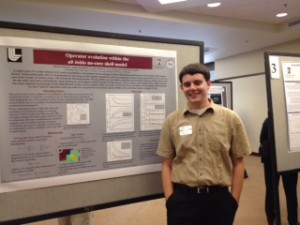
Micah Schuster Poster Title: “Operator evolution within the ab initio no-core shell model” Abstract: A major goal of nuclear theory is to make quantitative calculations of low-energy nuclear observables starting from microscopic internucleon forces. Computationally, this is complicated by the large model spaces needed to reach convergence in many-body approaches, such as the no-core shell model. In recent years, the Similarity Renormalization Group (SRG) has provided a powerful and versatile means to soften interactions for ab initio structure calculations, thus leading to convergence within smaller model spaces. Until recently, and to great effect, SRG evolution has been applied exclusively to the Hamiltonian of the nuclear system. Here we study, for the first time, the effects of three-body SRG evolution on the r2 and D2 operators and use them to compute the root mean square (RMS) radius and total dipole strength of 4He.
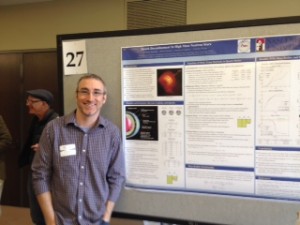
William Spinella Poster Title: “Deconfined Quark Matter in High Mass Neutron Stars” Abstract: Using a non-local extension of the Nambu-Jona-Lasinio model to describe quark matter and relativistic mean field theory to describe hadronic matter, we show that mixed phases of deconfined quark matter and confined hadronic matter may exist in neutron stars as massive as 2.35 solar masses.
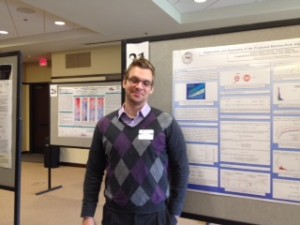
Joshua Staker Poster Title: “Exploration and Expansion of the Projected Hartree-Fock Algorithm in a Shell Model Basis” Abstract: We have seen that the Projected Hartree-Fock (PHF) algorithm shows promise for computing nuclear spectra, especially in cases of Even-Z Even-N nuclei, when compared to the exact Configuration Interaction (CI) results. We now look to identify possible sources of error in PHF by examining the CI-PHF spectral variance with respect to the quadrupole nuclear deformation parameters, as well as examining expectation values of spin (S^2) and isospin (T^2) operators. Additionally, we examine the improvement to the PHF spectra when expanding the basis to include not only the global minimum Hartree-Fock Slater determinant, but local minima as well.
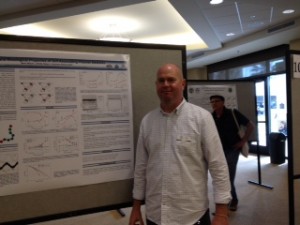
Mark Wilson Poster title: “Structure and Rheological Properties of Self-Associating Polymer Networks” Abstract: Systems of associating polymers possess the ability to span a large spectrum of material properties, from fluid-like viscosity to near solid-like elastic dynamics. Relatively small changes in external parameters can result in large transitions in this behavior. In the following, numerical simulations of associating polymers are utilized to study viscoelastic behavior. A hybrid Molecular Dynamics, Monte Carlo (MC) algorithm is employed. Polymer chains are modeled as a course grained bead-spring system. Functionalized end groups, at both ends of the polymer chains, can form reversible bonds according to MC rules. At high temperatures the system is shown to behave as a fluid. Decreasing the temperature below the micelle transition results in a self-assembly of the system, forming a network that is transient in time. The nodes of this network consist of aggregates of end groups, while links between aggregates are formed by one or more bridging polymer chains. We report on the macrostructural changes in a polymer network that arise in response to an oscillatory shear. The stress response has been obtained as a function of the oscillatory frequency and amplitude in both the linear and nonlinear regimes. Data are correlated with observed changes in the network structure. For instance, a reduction in the number of links is observed at large amplitude or low frequency. This is partly due to an increase in the number of loops (chains that have both ends connected to the same aggregate). The secondary cause is a tendency of the chains to form additional bridges between the same sets of aggregates. We have also studied the lifetime of aggregates and found that the lifetime is shortest near the walls that bound the system. Finally, we will report on very intriguing transient phenomena in the moduli, as well as the structure and dynamics of the networks.
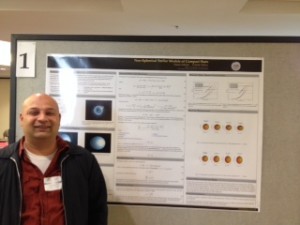
Omair Zubairi Poster Title: “Non-Spherical Stellar Models of Compact Stars” Abstract: Conventionally, the structure of compact stellar objects such as neutron or quark stars are modeled with the assumption that they are perfect spheres. However, due to high magnetic fields, certain classes of compact stars (such as magnetars and neutron stars containing cores of color-superconducting quark matter) are expected to be deformed (non-spherical) making them oblonged spheroids. In this work, we seek to investigate the stellar structure of these such deformed compact objects in the framework of generalrelativity. Using a metric that describes a non-spherical mass distribution, we derive the stellar structures equations of these non-spherical compact objects, Parameterize these structure equations in polar and radial directions, calculate stellar properties such as mass and radii of these objects, and investigate any changes from the standard spherical models.

